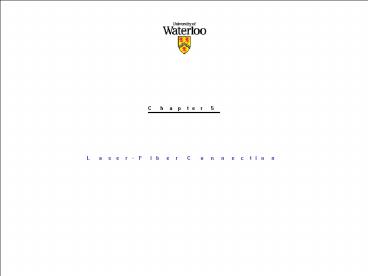Laser-Fiber Connection - PowerPoint PPT Presentation
1 / 22
Title:
Laser-Fiber Connection
Description:
Chapter 5 Laser-Fiber Connection Content Launching optical power into a fiber Fiber-to-Fiber coupling Fiber Splicing and connectors Coupling Efficiency Radiance ... – PowerPoint PPT presentation
Number of Views:77
Avg rating:3.0/5.0
Title: Laser-Fiber Connection
1
Chapter 5
- Laser-Fiber Connection
2
Content
- Launching optical power into a fiber
- Fiber-to-Fiber coupling
- Fiber Splicing and connectors
3
Coupling Efficiency
5-1
Source
Optical Fiber
4
Radiance (Brightness) of the source
- B Optical power radiated from a unit area of the
source into a unit solid angle watts/(square
centimeter per stradian)
5
Surface emitting LEDs have a Lambertian pattern
5-2
6
Edge emitting LEDs and laser diodes radiation
pattern
5-3
For edge emitting LEDs, L1
7
Power Coupled from source to the fiber
5-4
8
Power coupled from LED to the Fiber
5-5
9
Power coupling from LED to step-index fiber
- Total optical power from LED
5-6
5-7
10
Equilibrium Numerical Aperture
11
Examples of possible lensing schemes used to
improve optical source-to-fiber coupling
efficiency
12
Laser diode to Fiber Coupling
13
Fiber-to-Fiber Joint
- Fiber-to-Fiber coupling loss
- Low loss fiber-fiber joints are either
- 1- Splice (permanent bond)
- 2- Connector (demountable connection)
5-8
14
Different modal distribution of the optical beam
emerging from a fiber lead to different degrees
of coupling loss. a) when all modes are equally
excited, the output beam fills the entire output
NA. b) for a steady state modal distribution,
only the equilibrium NA is filled by the output
beam.
15
Mechanical misalignment losses
Lateral (axial) misalignment loss is a dominant
Mechanical loss.
5-9
16
Longitudinal offset effect
Losses due to differences in the geometry and
waveguide characteristics of the fibers
5-10
E R subscripts refer to emitting and receiving
fibers.
17
Experimental comparison of Loss as a function of
mechanical misalignment
18
Fiber end face
Fiber end defects
19
Fiber splicing
Fusion Splicing
20
V-groove optical fiber splicing
21
Optical Fiber Connectors
- Some of the principal requirements of a good
connector design are as follows - 1- low coupling losses
- 2- Interchangeability
- 3- Ease of assembly
- 4- Low environmental sensitivity
- 5- Low-cost and reliable construction
- 6- Ease of connection
22
Connector Return Loss

